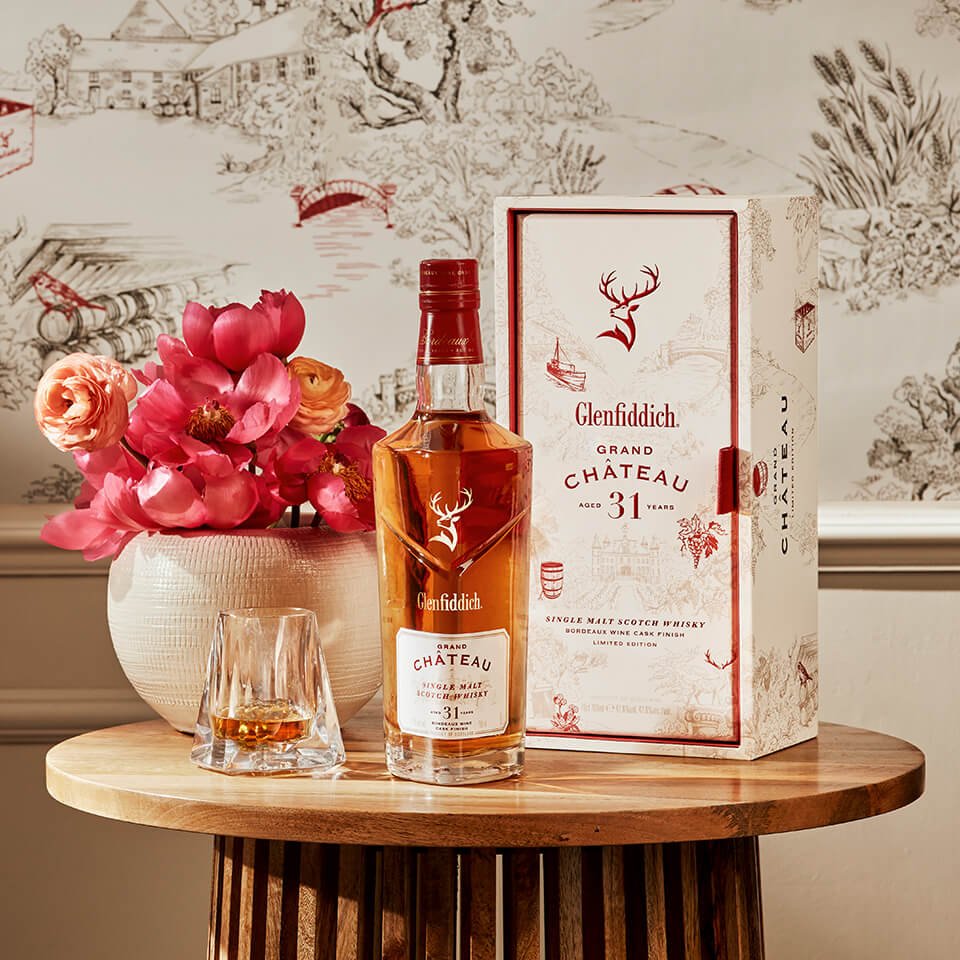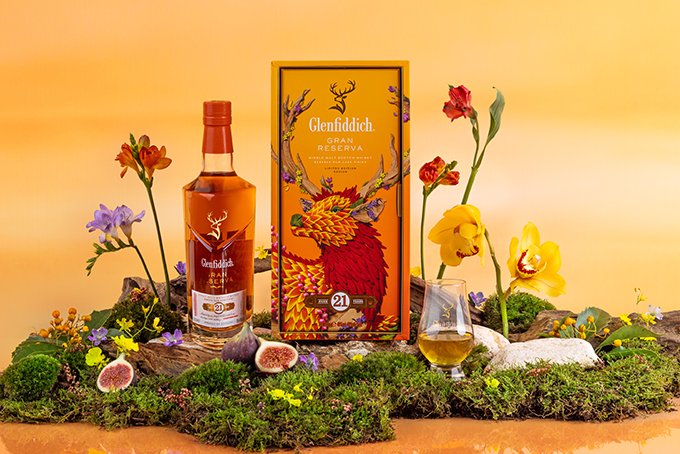Introduction
Glenfiddich is one of the most iconic names in the world of Scotch whisky. Known for its rich history and consistent quality, Glenfiddich’s flavor profile has captivated whisky lovers for over a century. But what makes Glenfiddich’s taste so distinctive? Is it the heritage of the distillery, the unique cask-aging process, or the meticulous craftsmanship that goes into each bottle? In this article, we will break down the elements that contribute to Glenfiddich’s remarkable flavors, from the distillation process to the aging techniques, the blending of different cask types, and the subtle notes that dance on the palate.
1. The Distillery’s Influence on Flavor
Before diving into Glenfiddich’s specific flavors, it’s important to understand the environment where this iconic whisky is made. Situated in the heart of Scotland’s Speyside region, Glenfiddich benefits from the ideal conditions for whisky production: clean, crisp water from the nearby Robbie Dhu spring, a mild climate, and the surrounding lush green landscapes. The location contributes to the purity of the whisky’s water, which is an essential element in the distillation process.
The Glenfiddich distillery is known for its traditional craftsmanship, where time-honored methods such as copper pot stills and wooden washbacks are used. These techniques preserve the natural essence of the whisky, allowing it to develop the rich and complex flavors that have made it so sought after.
2. The Role of Barley: A Foundation for Glenfiddich’s Character
The base ingredient in any whisky is barley, and Glenfiddich’s selection of high-quality barley is key to its distinctive flavor. Glenfiddich uses Scottish barley, which is carefully malted, mashed, fermented, and distilled to create a clean, smooth base spirit. The choice of barley, coupled with the natural yeast used in fermentation, creates a malt whisky that is rich, light, and malty – the perfect foundation for the other layers of flavor that come with aging and cask influence.
3. The Distillation Process: Crafting the Perfect Spirit
Glenfiddich’s distillation process is designed to extract the purest spirit while maintaining complexity and depth. The whisky is distilled in copper pot stills, which are known to help retain the rich and complex aromas that form in the fermentation process. This copper still process allows Glenfiddich to create a spirit that is delicate and flavorful, providing a balance between sweetness and subtle complexity. The distillation process is carefully monitored to ensure the right balance of the “heart” (the purest part of the distillation) is captured, which is crucial for developing the whisky’s unique characteristics.
4. The Aging Process: The Heart of Glenfiddich’s Flavors
Aging is one of the most important factors in shaping Glenfiddich’s flavor profile. Glenfiddich’s maturation process involves a combination of traditional oak casks, which can include American oak barrels, European oak sherry casks, and occasionally other types like rum or wine casks. Each cask type imparts different characteristics to the whisky, resulting in a balanced complexity of flavors.
American Oak Barrels
American oak casks are used in many Glenfiddich expressions, particularly for their 12-year-old single malt. These barrels impart a smooth, creamy texture, often bringing out vanilla and honey notes. The wood’s tight grain helps the whisky develop a more subtle yet sweet flavor profile, rich with hints of toffee and oak.
Sherry Casks
The influence of sherry casks is crucial for Glenfiddich’s more mature offerings, particularly in expressions like the Glenfiddich 18 Year Old. Sherry casks contribute a deep, rich complexity to the whisky, with notes of dried fruit, spice, and dark chocolate. The longer aging process in sherry casks allows for the development of deeper flavors, including dried apricots, figs, and nutty elements.
Other Wood Finishes
Glenfiddich is also known for experimenting with different cask finishes, which influence the flavor of their whiskies. These include rum casks, port casks, and wine casks. Such expressions add unique flavors such as tropical fruit, spice, or berry notes, further expanding Glenfiddich’s range of flavor profiles.

5. Tasting Notes of Glenfiddich: A Journey of Flavors
Now, let’s dive into the flavors that define Glenfiddich’s whiskies. While each expression is unique, there are certain notes that you can expect to encounter in many of their offerings.
Glenfiddich 12 Year Old
As the signature expression from Glenfiddich, the 12 Year Old is the most recognized and widely available. The whisky offers a balanced flavor profile, with light, floral notes of fresh pear and apple. The maltiness of the barley shines through with hints of toffee and vanilla, rounded out by the subtle influence of oak and a delicate sweetness that lingers on the finish.
Glenfiddich 15 Year Old
Glenfiddich’s 15 Year Old is known for its complex character, which is the result of a process called “Solera Vatting,” a method that uses a large wooden vat to blend whisky from different casks. This expression is rich and warming, with flavors of dried fruit, spice, and honey. The sherry cask influence adds depth, with hints of ginger, cinnamon, and dark chocolate joining the more prominent fruity notes.
Glenfiddich 18 Year Old
The Glenfiddich 18 Year Old is a deeper, more sophisticated whisky. The sherry cask influence is more pronounced here, contributing rich flavors of dried fruits like raisins, figs, and cherries. There’s a complexity of oak flavors, including leather and tobacco, which develop with the longer aging process. It’s a balanced whisky with a smooth, elegant finish.
Glenfiddich 21 Year Old
The Glenfiddich 21 Year Old is known for its unique rum cask finish. This expression has a sophisticated balance of flavors, combining the fruity sweetness of tropical fruits with rich, nutty undertones. The rum cask imparts flavors of dark molasses, caramelized sugar, and a slightly spicy finish. This expression is complex and smooth, showcasing the full potential of Glenfiddich’s aging process.
6. Glenfiddich’s Unique Character: What Sets It Apart
What truly sets Glenfiddich apart from other single malt whiskies is its exceptional consistency and commitment to quality. The distillery’s long history and dedication to traditional methods ensure that each bottle of Glenfiddich is crafted with care and precision. Additionally, the whisky’s versatility, with its range of expressions from light and floral to rich and robust, makes it appealing to both new whisky drinkers and seasoned connoisseurs alike.
Glenfiddich’s flagship 12 Year Old offers a gentle introduction to the world of whisky, while the older expressions showcase a level of sophistication and depth that is appreciated by collectors and enthusiasts. The brand’s ability to innovate with various cask finishes, such as rum and wine casks, further pushes the boundaries of what is expected from a traditional Speyside whisky.
7. Conclusion: The Enduring Appeal of Glenfiddich
Glenfiddich has cemented its position as one of the world’s premier whisky brands, and its flavor profile is a significant reason for this. From the use of high-quality barley and careful distillation techniques to the aging process in a variety of cask types, Glenfiddich’s commitment to creating the finest single malt whisky is evident in every bottle. Whether it’s the fruity, floral notes of the Glenfiddich 12 Year Old or the rich, sherried complexity of the 21 Year Old, each expression offers a unique and memorable experience.
So, what makes Glenfiddich’s flavor profile so unique? It is a combination of tradition, craftsmanship, and a willingness to innovate. These elements come together to create a whisky that is both accessible to new drinkers and complex enough for whisky connoisseurs, making it a beloved brand across the globe.































